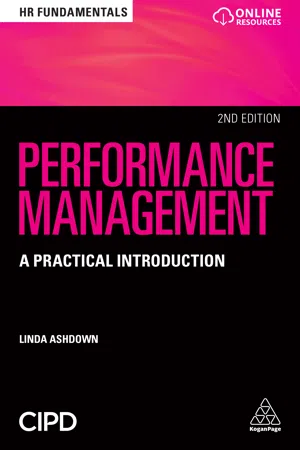Business
Manager Performance
Manager performance refers to the effectiveness and efficiency with which a manager carries out their responsibilities and achieves their goals. It encompasses the ability to lead, make decisions, communicate effectively, and drive results within a team or organization. Evaluating and improving manager performance is crucial for the overall success and productivity of a business.
Written by Perlego with AI-assistance
Related key terms
11 Key excerpts on "Manager Performance"
- eBook - ePub
Managing Others: The Organisational Essentials
Your guide to getting it right
- Chartered Management Institute(Author)
- 2013(Publication Date)
- Profile Books(Publisher)
Performance managementMichael Armstrong and Angela Baron, two well-known writers on human resource management, define performance management as ‘a process which contributes to the effective management of individuals and teams in order to achieve high levels of organisational performance. As such, it establishes shared understanding about what is to be achieved and an approach to leading and developing people which will ensure that it is achieved.’ They stress that it is ‘a strategy which relates to every activity of the organisation set in the context of its human resource policies, culture, style and communications systems’.Performance management is an integrated approach to helping an organisation achieve its aims and objectives by monitoring and improving the performance of individuals, departments and the organisation as a whole. This checklist aims to provide an understanding of the principles of performance management. It outlines the main issues to be considered in the introduction and operation of a performance management scheme at organisational level, and provides guidance for individuals on how to take advantage of performance management to improve their personal performance and develop their potential. A performance management system uses agreed targets and objectives to enable managers to measure and review performance, giving a clear indication as to whether the activities undertaken by individuals are contributing to the achievement of organisational goals.Current levels of performance are not always what an organisation and its employees would like them to be. Individuals can work to narrow this gap by becoming more productive, developing their skills, or becoming better informed; organisations can improve processes, systems and procedures. To be effective, performance review must be conducted in the context of an organisation’s overall strategic plan, with the aim of generating the momentum required to achieve corporate goals. - eBook - ePub
Armstrong's Handbook of Performance Management
An Evidence-Based Guide to Performance Leadership
- Michael Armstrong(Author)
- 2022(Publication Date)
- Kogan Page(Publisher)
02The conceptual framework of performance management
Introduction
Performance management is carried out more effectively if the relevant concepts relating to performance – the meaning of performance, the distribution of performance, the factors affecting individual performance, the underpinning theories, and the significance of the psychological contract – are understood and applied. The purpose of this chapter is to describe these concepts and examine their practical significance.The meaning of performance
If you can’t define performance, you can’t manage it. Bates and Holton (1995: 279) pointed out that: ‘Performance is a multi-dimensional construct, the measurement of which varies depending on a variety of factors.’ They also stated that it is important to determine whether the measurement objective is to assess performance outcomes or behaviour.Latham et al (2007) emphasized that an appropriate definition of performance is a prerequisite for feedback and goal-setting processes. They stated that a performance theory is needed that stipulates:- the relevant performance dimensions;
- the performance standards or expectations associated with different performance levels;
- how situational constraints should be weighed (if at all) when evaluating performance;
- the number of performance levels or gradients;
- the extent to which performance should be based on absolute or comparative standards.
There are different views on what performance is. It could just mean outcomes – the results obtained, or it could mean behaviour – how the results were obtained, or it could be both results and behaviour.Performance as outcomes
Bernadin et al - eBook - ePub
People Practice
A Complete Guide
- Karen Waite, Kathy Beevers, Nicky Small, Keith Tomlinson, Shazad Hussain(Authors)
- 2021(Publication Date)
- CIPD - Kogan Page(Publisher)
Performance management could be said to be about doing the right things as well as doing things right. It is about ensuring that employee efforts are focused on activities that will fulfil organisational goals, and that those activities are carried out to the required standard.This, and all the benefits listed above, would be considered desirable by most organisations and their employees, and so it is not difficult to understand why almost all organisations attempt to implement some form of performance management system.Meanings and definitions
Performance management
The term ‘performance management’ is used in a number of different ways, often depending on people’s experience of it. Consequently, for some, ‘performance management’ is an overarching term which covers the full spectrum of people management, from induction through to allocating work, agreeing performance objectives, monitoring work, informing reward decisions, managing poor performance and recognising high performance. However, for those at the other end of the scale, ‘performance management’ can simply refer to an annual appraisal event.In many ways, performance management has evolved from an earlier management approach known as ‘management by objectives’ (MBO). MBO, popularised by a number of management gurus, most notably Peter Drucker (1954) and John Humble (1972) has an emphasis on goal setting and ensuring that goals are firmly aligned across the whole organisation. Organisation goals are cascaded downwards into team objectives, which in turn cascade into individual performance objectives. Performance is then closely monitored and measured, with individual performance outcomes feeding back up into team outcomes and ultimately into the achievement of organisational goals.While MBO promoted worker agreement and some ownership of objectives, the tight management controls involved conflicted with the gradual shift towards greater worker autonomy and self-regulation. The approach was also sometimes criticised for taking insufficient account of the different factors, other than worker performance, that can affect the extent to which organisational goals are achieved. - eBook - ePub
Managing People
A Practical Guide for Front-line Managers
- Rosemary Thomson, Eileen Arney, Andrew Thomson(Authors)
- 2015(Publication Date)
- Routledge(Publisher)
• It is strongly associated with development and especially identifying what development is needed.At one level performance management is strategic in that it is concerned with integrating the different dimensions of an organisation’s operations into its wider objectives, but it is also concerned with the role of the individual manager and, indeed, expects responsibility to be shared by all members of the organisation. The integration is primarily vertical, aligning organisational, team and individual objectives, but can also be functional, bringing together functional strategies in different parts of the organisation and within functions, such as integrating different aspects of managing people.The aim of performance management is continuously to improve the performance of individuals and that of the organisation. It involves making sure that the performance of employees contributes to the goals of their teams and the business as a whole. The system is operated on an annual cycle which evaluates the past, sets future objectives, plans for the development needed to achieve those objectives, and potentially links to a framework of rewards, whilst there is also an ongoing record of progress and constant feedback on performance. This annual cycle is central to the whole concept of performance management, which has four distinct stages, although the review and the plan stages are usually carried out at the same time through the appraisal system, whilst the develop and perform stages are carried out continuously throughout the year. - eBook - ePub
Strategic People Management and Development
Theory and Practice
- Gary Rees, Ray French, Gary Rees, Raymond French(Authors)
- 2022(Publication Date)
- CIPD - Kogan Page(Publisher)
how it is done. Purcell et al (2003) provide research evidence to support the proposition that no one particular HR practice is critical to organisational success, but rather that good management by line managers, applying various approaches effectively and appropriately according to the context, is the key factor. Committed and capable line managers are, therefore, essential to successful PM (Hutchinson and Purcell, 2003). These managers need to know the ‘how’ of PM as much as the ‘what’; that is, the answers to questions such as:- How can we define performance?
- Who should define performance?
- How can we measure performance?
- What is the link between motivation and performance?
10.5.2 Defining performance
For performance to be managed it has to be defined and measured. This demonstrates that what the organisation measures is indicative of what the organisation values (Johnson et al, 2011).There is no single, universal definition of performance; it depends very much on the particular perspective adopted. For example, some definitions relate to the organisation and various expectations in terms of outputs: Performance should be defined as the outcomes of work because they provide the strongest linkage to the strategic goals of the organisation, customer satisfaction, and economic contributions (Bernadin, Kane and Ross, 1995).Other definitions emphasise behavioural aspects, in addition to outputs or results: Performance means both behaviours and results. Behaviours emanate from the performer and transform performance from abstraction to action. Not just the instruments for results, behaviours are also outcomes in their own right – the product of mental and physical effort applied to tasks – and can be judged apart from results (Brumbach, 1988, p 389).10.5.3 Who defines performance?
It is not only a question of how performance is defined, but also who - eBook - ePub
Performance Management
A Practical Introduction
- Linda Ashdown(Author)
- 2018(Publication Date)
- Kogan Page(Publisher)
Performance management is made up of many activities that when managed holistically can lead to effective people management. The particular challenge of providing a clear, comprehensive definition of performance management is that it covers such a breadth of activities. It is also difficult to define precisely as the nature of performance management will and should vary according to the organization context. The sector, structure, size, culture, strategy and leadership of the organization will all influence the nature of performance management. One of the most often used definitions is that of Armstrong (2009): ‘Performance Management is a systematic process for improving organizational performance by developing the performance of individuals and teams.’ One of the reasons this definition has proved so popular is because at its heart is the crucial issue of the link between the performance of an organization’s human resources and the achievement of organization goals. ‘Alignment’ is a key ingredient in successful performance management systems: the alignment of an individual’s performance to the goals of the organization.A senior director I worked with in the advertising industry once told me that he regarded effective performance management as having an invisible thread linking the organization’s mission statement to the performance objectives of the individual – and that image has stayed with me both in my practice as an HR professional and when teaching human resource management (HRM) to others. I firmly believe that the core principle of everyone working for an organization having a clear understanding of how they contribute to the mission, vision and goals of the organization is an important one. There is a real benefit to the organization of having all the people who work for it focused on the right things to add value. There are also clear benefits for the employees of that invisible thread being in place. For example, the intrinsic satisfaction of feeling significant, understanding their contribution and ultimately feeling valued by the organization – that invisible thread helps to deliver that understanding and those feelings. This is a powerful enabler for retaining staff and supporting them to deliver high-performance outcomes. Individuals are much more likely to ‘go the extra mile’ for those organizations where they understand and value the organization’s goals and believe that they can contribute to the achievement of those goals and will be valued for doing so. Unfortunately, in many organizations that connection between the organization’s goals and individual contribution is either weak or missing altogether; this has the potential to impact detrimentally on both the performance of the individual and that of the organization. - eBook - ePub
Effective People Management
Your Guide to Boosting Performance, Managing Conflict and Becoming a Great Leader in Your Start Up
- Pat Wellington(Author)
- 2017(Publication Date)
- Kogan Page(Publisher)
07Performance management
Introduction
Performance management is helping a member of your staff understand their role and responsibilities, and their individual contribution to realizing business objectives through achieving planned and agreed results. Many organizations also use performance management in career planning and personal development.What does a member of staff expect from their manager?- Where the team and individuals are headed. This is the business vision.
- Why they are headed there (and not somewhere else). This is the business mission or why the organization exists.
- What it looks like when they get there. How our objectives and efforts help us to deliver the organization’s mission and business plans.
- How we should behave and work together as a team. This is all about the organization’s culture.
So if you are recruiting someone into your team, jointly agree with them what you expect (and do not expect from them) in terms of performance and behaviours. This is where key results areas (KRA) and targets are required.Key results areas flow from individual or team job descriptions. KRAs contribute towards clarifying how we should (as a team) be spending our time . For the team’s strategy to succeed all team members must achieve specific results, which when accumulated, ensure that all strategy elements are delivered. KRAs are a summary of those key factors of an individual’s job or the team’s job that are vital for the team’s success. They must be monitored, at a minimum, each month to ensure keeping on track with your strategy.If you have difficulty identifying your KRAs ask yourself the following question: ‘What are the major aspects of the team’s work that could go wrong?’ You might say ‘We don’t realize our sales target’, ‘We use up our resources’, ‘Too many customers complain’ or ‘We don’t complete our reports on time’. These can be translated into the following KRAs – sales, finance, customer service and monthly reports. - eBook - ePub
A Global Guide to Human Resource Management
Managing Across Stakeholders
- Thomas Klikauer(Author)
- 2022(Publication Date)
- Routledge(Publisher)
7 Performing People Performance ManagementDOI: 10.4324/9781003293637-7Executive Summary
Performance management is a method used to assure the performance of managers and employees. It is widely used for white- as well as blue-collar workers and relates to the power management has over their workforce. It also links the past to the present and to the future as performance management becomes a strategic tool. Performance management is predominantly designed to improve performance. As such it is not just linked to strategy but is also part of organisational culture. HRM uses a number of performance methods to assess employee performance. Crucial to the success of performance management remains its link to organisational objectives that set clear goals for performance. To improve on performance, management collects performance information for performance appraisals that remain vital. Performance appraisals allow management to feed back performance information to employees. Key to a successful performance management system remains the removal of barriers that prevent employees from performing. These can be established in feedback sessions designed as “problem solving” discussions that avoid many of the pitfalls of traditional performance management systems.Key Learning Objectives
- Realise the importance of performance management (PM);
- Examine the general purpose of PM;
- Discuss the role of PM in relation to business performance;
- Detect the chief determinants of individual performance;
- Select an appropriate PM method for a given situation;
- Delineate the cultural influence of PM;
- Describe what performance management is “not” designed to do;
- List the most common problems of PM; and
- Develop a formal performance management policy.
Managing People and Their Performance
Performance management is one of the most used, useful, and controversial tools of Human Resource Management (HRM) performed daily in many companies. At the very basis of performance management lies the idea to make people in organisations perform their assigned duties.1 Performance management is even linked to one of the more classical definitions of management. This is a description delivered by the former Harvard Business Review editor – Joan Magretta – who noted, “managers, using the word loosely, to refer to people in positions of institutional power”.2 Power is a rather interesting and highly prevalent concept in HRM and performance management.3 - eBook - ePub
Essential Tools for Organisational Performance
Tools, Models and Approaches for Managers and Consultants
- Simon Burtonshaw-Gunn, Malik Salameh(Authors)
- 2009(Publication Date)
- Wiley(Publisher)
Indeed, key to the successful introduction and ongoing application of performance management is having: • a clear understanding about the process and what it is meant to contribute to the business. • an understanding of the current organization and how it should function in a high-performance culture. • a recognition that individuals will need to be focused and assigned mutually agreed SMART objectives for them to “buy in” to performance management and play their part. • an understanding that, although a performance management system may be documented and capable of being deployed widely across an organization, the other aspects of business cannot be ignored or treated in isolation if the “close but no cigar” criticism is to be avoided. Figure 3.9 Features of traditional and empowered organizations. (From The Essential Management Toolbox: Tools, Models and Notes for Managers and Consultants. S.A. Burtonshaw-Gunn, 2008, reproduced with permission.) While performance management is about developing and implementing appropriate business processes, it also needs the support of people - as previously mentioned and widely heralded as a company’s key asset. It is suggested that for an organization to gain the maximum value from a performance management system it has to be configured to functionally operate in a predictive way. This provides a capability for strategic leaders to analyse the performance hierarchy to pinpoint the source of any underperformance within their organization and implement appropriate corrective actions through support, development and training - eBook - ePub
- D. Crowther(Author)
- 2007(Publication Date)
- Routledge(Publisher)
Feedback is necessary so that individual managers can be informed of how the business is performing in relation to the planned level of performance and in order to indicate what corrective action needs to be taken in order to correct deviations from the plan. Thus individual managers need feedback on the performance of that part of the business for which they are responsible. Accounting information from the accounting control system, in the form of reports on current performance, is an important part of the feedback. This feedback needs to be frequent and regular but also needs to be timely so that the feedback is received as soon after the action as possible. This is important in order to ensure that the feedback can be related to the actual decisions made and to ensure that any corrective action can be speedily taken. Detailed feedback given long after the event is of little value in the operations of a business.Figure 10.1 The control systemWe have previously considered how accounting information can be used to help managers control that part of the business for which they are responsible. It is not sufficient, however, for each individual manager to ensure the optimum performance of his/her area of responsibility because this will not in itself necessarily lead to the optimisation of overall company performance. For optimum performance for the company, managers need to be aware of what the company’s objectives are and how their own performance in the particular area for which they are responsible fits into the overall company plan. Equally the feedback on current performance needs to detail not just the performance of their own particular area but also the performance of the company as a whole. This will help managerial performance by enabling managers to assess their performance individually in terms of the overall company performance, and also help them to feel more involved in company performance. It also facilitates synergy as managers can see how certain action which they might take can influence company performance even if it does not necessarily improve their individual performance. Thus a team approach to management leads to better performance than does an individualistic approach.The control of the performance of a business needs to be considered in terms of the people who are involved in that business and behavioural scientists have investigated in detail the factors that lead to improved performance in people. McGregor (1960) in his book, The Human Side of Enterprise, stated:Every managerial decision has behavioural consequences. Successful management depends – not alone, but significantly – upon the ability to predict and control human behaviour.McGregor argued that managers’ behaviour towards others was influenced by their assumptions regarding human nature. He separated these assumptions into two categories – Theory X and Theory Y. Theory X is based upon the assumption that people dislike work and will avoid it if at all possible, and that they have little ambition, want to avoid responsibility and be directed. Theory X therefore assumes that people need to be controlled and directed in order to get them to put effort into the achievement of organisational objectives. - eBook - ePub
Talent
Making People Your Competitive Advantage
- Edward E. Lawler(Author)
- 2010(Publication Date)
- Jossey-Bass(Publisher)
CHAPTER FIVEMANAGING PERFORMANCEIn an HC-centric organization, “talent management” is important, but “performance management” is even more so. Talent management is the critical factor in determining the potential performance of individuals, groups, and organizations, but the ability to manage performance is often the major differentiator between organizations that produce adequate results and those that excel. Without a focus on performance management at all levels of an organization, it is hard to see how it can find competitive advantage through its talent. Simply stated, in an HC-centric organization an effective performance management system is not optional, it is a must-have.It is far from easy to get performance management right in any organization. The corporate world is littered with companies whose employees regularly game their performance reviews to their advantage.1 People at all levels go through the motions of formulaic performance reviews with astonishing insincerity and have little to show for it. There also are numerous examples of situations where individuals thought they were doing the right thing only to find out they were mistaken. Finally, in many organizations, performance reviews simply aren’t done either because of employee resistance or because managers “dry lab” (fake) them.An effective performance management system needs to accomplish four things. First, it needs to define and produce agreement on what type of performance is needed. The bedrock of any performance management system should be agreement on what needs to be done and how it should be done. Without a clear definition of what kind of performance is desired, it is impossible to develop and motivate individuals who can meet or exceed performance standards! It also is key to guiding the performance of individuals so that it supports the organization’s strategy and plans.
Index pages curate the most relevant extracts from our library of academic textbooks. They’ve been created using an in-house natural language model (NLM), each adding context and meaning to key research topics.










